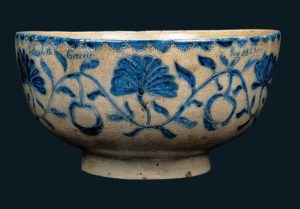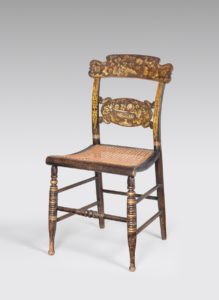Made in New York City at the American Folk Art Museum
The exhibition Made in New York City: The Business of Folk Art is on view at the American Folk Art Museum (AFAM) through July 28, 2019. The exhibit includes 100 hundred works by self-taught artists from the 18th, 19th, and early 20th centuries and highlights the history of New York City as a financial and commercial capital. The show was curated by Elizabeth V. Warren, independent curator and author, with Stacy C. Hollander, the AFAM’s deputy director for curatorial affairs and chief curator.
“The exhibition could not be more timely, as it is presented when the Museum is celebrating the 30th anniversary of being in the center of New York’s cultural life at Lincoln Square,” says Jason T. Busch, director of the museum, who welcomed Trust members on June 27 for a tour with Ms. warren. “This exhibition of remarkable, richly sourced works of traditional folk art offers visitors a deeper understanding of American history and crystallizes the importance of self-taught art in the rise of the Empire City.” New York City is and always was a city of immigrants, and those immigrants brought with them the skills and traditions of their native countries. English portrait painters, German potters, Jewish woodcarvers from Eastern Europe, and French Huguenot school teachers quickly established themselves in their new home, pursuing portrait painting, ceramics, wood carving, and stitched textiles.
“Folk art has flourished in New York City since the 18th century. Contrary to popular belief, it was not just a rural genre. In fact, many of the objects that have been associated with the ‘country’ were made in the five boroughs of New York,” says Warren. “The Washburne and Fiske companies of New York, for example, manufactured many of the weathervanes that crowned barns and farmhouses throughout the country. The stoneware crocks in country stores often had their origins at Thomas Commeraw’s pottery in what is now the Lower East Side, or the MacQuoid shop on Little West 12th Street. And thousands of the carousel animals enjoyed by children across America were carved in Coney Island.”
“From its earliest days as a Dutch colony, New York was intended to operate as a commercial center. It grew from trading furs and sending the profits back to the Netherlands into a mercantile center that, by the time of the Revolutionary War, was self-sufficient enough to produce many of the objects of daily life that once had to be imported,” said Warren. The exhibition draws from the collections of a number of New York City museums, including the AFAM, The New-York Historical Society, Cooper Hewitt Smithsonian Design Museum, Historic Richmond Town, the Metropolitan Museum of Art, and several historical societies and museums in all five boroughs, as well as private collections.
Made in New York City tells a story from two perspectives. “The Art of Business” focuses on the people and places that were part of the city’s thrumming commercial life. “The Business of Art” highlights the products of the artists, artisans, and manufacturers, such as commercial signs, store figures, and early advertising images. The people and places that were integral to the city’s financial and commercial activity are brought vividly to life through a number of portraits painted by self-taught artists, as well as landscapes and seascapes showing young New York City bustling with commercial activity.
A highlight from the “Art of Business” portion of the exhibition is an Optician’s Trade Sign by E. G. Washburne & Co. (Figure 1). When the sign was manufactured in the early 20th century, E. G. Washburne & Co. was well established on Fulton Street in Manhattan. Traditionally, hanging signs were made of wood and were double-sided so that they could be easily visible from two directions. This sign continues that tradition but was made of zinc and copper instead of wood and was electrified. This last characteristic points to its probable production around 1915, when access to electricity was available. Washburne & Co.’s eyeglass signs were so popular that the company published a trade catalogue.
“The Business of Art” section displays many of the products found “in the country” that were thought to have been produced there. However, these objects were often manufactured in New York City by artists and artisans who, in the tradition of self-taught artists around the world, learned their skills by joining family businesses, apprenticing to masters, or by teaching themselves the expertise needed to produce the pieces we now consider among the core expressions of American folk art.
An impressive stoneware punch bowl was likely a special commission (Figure 2). The form of the bowl is inspired by Chinese export porcelain of the period and is both finer (thinner and more elegantly shaped) and more delicately decorated than most contemporary American stoneware. The exterior is emblazoned with elaborate foliate cobalt decoration. Dated 1811 and bearing the name Elisabeth Crane, the bowl is traditionally attributed to John Crolius, Jr. Recent research suggests, however, that the bowl may have been made by Caleb Crane, a potter in the Crolius workshop, as a gift for his wife Elizabeth or as a christening bowl for his daughter, who was also named Elizabeth. Beginning around 1728, generations of the Crolius family, originally from the German Rhineland, operated one of America’s earliest stoneware potteries and produced a wide variety of salt-glazed wares in New York City’s lower Manhattan.
Another example of the quintessential New York story as told through the exhibition is that of Solomon Stein and Harry Goldstein. They were already skilled woodworkers when they emigrated from Russia in 1899, but they learned the art of carving carousel figures while working for W. F. Mangels Co. Carousel Works in Coney Island (Figure 3). In 1909, they formed the Artistic Carroussell [sic] Manufacturing Company, where they combined their skill in carving with a successful entrepreneurial bent. The partners not only provided the animals, but also the machinery, and, subsequently, maintained ownership of the carousels as well. Initially, Stein’s and Goldstein’s horses were notable for their large size, but over time the carvers imbued the sculptures with elegance and grace by adding elaborate details to the trappings. One of their earliest carousels continues to operate in New York City’s Central Park.
As demand for fancy chairs increased in the 19th century, it was necessary to develop methods to expedite the manufacturing process. One solution was to use stencils for the decoration, rather than painting each design freehand (Figure 4). Thomas Jefferson Gildersleeve advertised on his trade card that he was a “gilder and maker of furniture and chairs of all description,” and parts of his stencil kit survive, including packets of metallic powders, papier-mâché boxes, a handmade stencil knife, etching tool, and original stencils.




